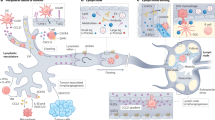Abstract
The efficacy of three murine monoclonal antibodies (MAbs) for immunoscintigraphy of small-cell lung cancer (SCLS) xenografts was studied in a Balb/c nu/nu mouse model. These Mabs, 123C3, 123A8 and MOC191, belong to cluster 1 of anti-SCLC MAbs and bind to the neural cell adhesion molecule (NCAM) with similar affinity. After intraperitoneal injection of these MAbs, labelled with 125I, the highest uptake in tumour tissue was obtained with MAb 123C3. Seven days after the administration of this MAb 13.9% of the injected dose per gram of tumour tissue was retained in the tumour. The corresponding tumour tissue ratios ranged from 3.97 for blood to 31.03 for colon. The imaging results and the tumour uptake were less favourable for the two other MAbs, 123A8 and MOC191 (fractions of injected dose respectively 6.7% and 9.2%), although affinity, biological activity after labelling and uptake in non-tumour tissues were very similar for all three MAbs. These results may be explained by the differences in the interaction between the MAbs and the tumour cells. Mab 123C3 is internalised into tumour cells, whereas both other anti-NCAM Mabs are not. Internalisation into NCI H69 cells was demonstrated in vitro by radioimmunoassay, confocal laser scanning microscopy and electron microscopy. The internalised fraction of MAb 123C3 was 22.3% after 24h, whereas this fraction was only 7.5% for MAb 123A8. Although the internalised radiolabeled Mabs are usually degraded and dehalogenated intracellularly, the retained radioactivity is high. Apparently, intracellular degradation of radiolabelled MAb 123C3 and subsequent secretion of radioactive iodine did not prevent the accumulation of intracellular radioactivity. In conclusion, accumulation and retention of radioactivity in the tumour tissue, due to internalisation of radiolabelled MAbs, may improve the results immunoscintigraphy.
This is a preview of subscription content, access via your institution
Access options
Subscribe to this journal
Receive 24 print issues and online access
$259.00 per year
only $10.79 per issue
Buy this article
- Purchase on Springer Link
- Instant access to full article PDF
Prices may be subject to local taxes which are calculated during checkout
Similar content being viewed by others
Author information
Authors and Affiliations
Rights and permissions
About this article
Cite this article
Kwa, H., Wesseling, J., Verhoeven, A. et al. Immunoscintigraphy of small-cell lung cancer xenografts with anti neural cell adhesion molecule monoclonal antibody, 123C3: improvement of tumour uptake by internalisation. Br J Cancer 73, 439–446 (1996). https://doi.org/10.1038/bjc.1996.79
Issue Date:
DOI: https://doi.org/10.1038/bjc.1996.79
This article is cited by
-
PankoMab: a potent new generation anti-tumour MUC1 antibody
Cancer Immunology, Immunotherapy (2006)



